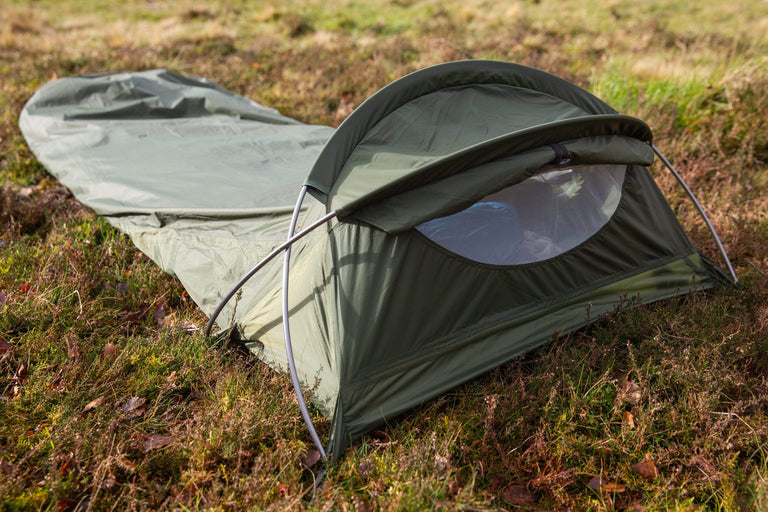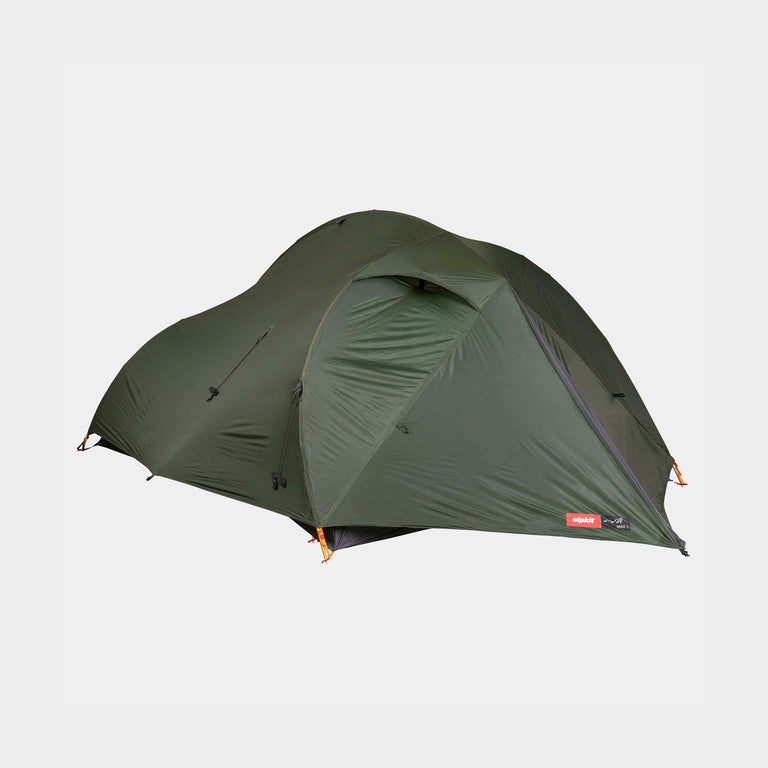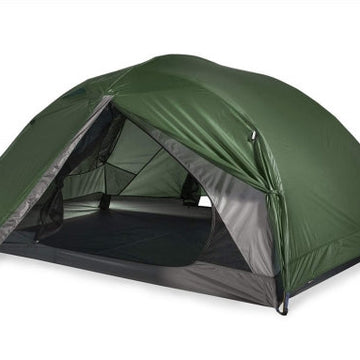
Alpkit Product Developer Rowan talks us through two new exciting additions to our backpacking tent range. The Aeronaut and the Polestar use innovative designs and the latest construction techniques for maximum packability.
We've been designing tents ever since work started on the first Kangri 13 years ago, and our design expertise goes back even further than that.
Alpkit co-founder Nick has over 20 years of experience in the tent industry, once working with alpinist Tomaž Humar to develop a single skin tent for his 2005 solo attempt on the Rupal Face of Nanga Parbat.
More than that though, we’re serious tent users – every last one us! We’re out using backpacking tents, mountain tents, campsite tents, shelters-so-basic-they-can-only-just-be-called-a-tent tents most of the year. This first-hand knowledge gives us an ability to identify any limitations to our own tents, as well as issues with other tents on the market.
Pole-free Tents
Aeronaut 1 and Aeronaut 2
The Aeronaut is a lightweight backpacking tent that uses an inflatable TPU ‘air pole’ in place of a standard alloy tent pole to produce an absurdly packable shelter.

How did the Aeronaut come about and what are its advantages?
“We were finding that there’s a lot of frustration in perfecting your bikepacking set-up, only to realise that you’ve still got to fit 40cm long poles somewhere on your bike – not an easy thing to do!
By using innovative new construction techniques, we were able to design a tent that fits neatly between the narrowest of drop bars and stuffs into the most awkward of seatpack spaces without using large alloy poles. Removing these rigid main poles removes one of the biggest obstacles to easy tent packing. But it’s not just bikepacking where this is a huge advantage. The packability of the Aeronaut makes it ideal for outdoor holidays abroad, lightweight backpacking, canoe and kayak camping – any activity with limited or awkward packing space.
With the Aeronaut 2, the other big benefit is being able to split the weight almost completely evenly between two people. If one person takes the tent outer (including air pole) and the other person takes the inner and pegs, you end up with roughly similar weights and pack-sizes to share.
Knowing that this tent would be ideal for bikepacking, we’ve included a Schrader valve on the air pole (as well as a standard two-way foot pump valve) to make use of the bike pump you’ll already be carrying. Pitching inner and outer together, once you’ve got a few pegs in, the Aeronaut inflates into place in minutes.”

What’s special about the inflatable pole?
“As well as the pack-size advantages, the inflatable pole also creates a really nice and stable structure. The Aeronaut is a pretty familiar tent shape, but by replacing the tent pole with an inflatable TPU pole we were able to create a lot more liveable space with a proper porch you can use – it’s a tent you’re happy to spend plenty of time in.
We were able to manipulate the shape of the Aeronaut in a way that we just wouldn’t be able to with an alloy pole tent. Metal poles are limited by something called ‘flexural strength’ – how far you can bend a pole before it snaps. Because the TPU pole is essentially a balloon, it will fill the available space of the pole sleeve it sits in. This allowed us to manipulate the pole to create the right dimensions for the tent. The curve in the centre of the Aeronaut is almost a perfect semi-circle which creates a really stable structure.
The other advantage to the inflatable pole is that in a very strong winds you don’t run the risk of your tent pole snapping – the TPU pole just moves where it needs to be moved to. Free of the limitations of flexural strength, this air pole will easily rebound back into shape rather than snapping like a single alloy pole might in the same situation.”



What else makes the Aeronaut stand out?
“We’ve used proper materials that are tried and tested to last longer. The fly sheet is the same rip-stop nylon fabric that we’ve used in Ordos backpacking tents. It’s got a really good level of tear resistance for its weight, the right hydrostatic head (a measure of waterproofing) for the kind of environments we expect the Aeronaut to be used in, and a low level of stretch which helps to create a really taught pitch.
It’s not just more internal space which make the Aeronaut more liveable either. We’ve designed the door to make it far easier to get in and out of the tent. By positioning the zips so that the doors fold into the footbox, we’ve been able to make the entry a much bigger area. We’ve also included a mesh pocket at the footbox end for you to easily stuff the door into, giving you more space inside the porch without anything getting in the way. Alloy micro-poles at the footbox end give you room to lie on your back without your feet poking into the flysheet, whilst still folding away to the same size as your tent pegs. We’ve also included 3 internal pockets for storing you head torch and other gadgets."



Polestar
Two and a half years in development and testing, the Polestar is a stable and reliable and sub-1kg 1-person tent that pitches using your own trekking poles to save on weight and packing space.

The Polestar has been in development for a while – what was the original thinking behind it?
“For long distance walkers (or 'thru-hikers' if you’re from the North American tradition), weight and pack-size are a big concern. But we also recognised that durability and useability are equally important – particularly in rough terrain and difficult environments. The big advantage of using trekking poles as tent poles is that you’re only carrying shared weight, not wasted weight. This allowed us to design a tent that saves on weight and pack-size without compromising on space or reliability.
The Polestar’s cross-pole design provides a really stable structure to the tent, and the tent has been engineered to ensure that the poles won’t flex, even in strong winds. We’ve designed it to be compatible with any brand of adjustable trekking poles or fixed length 120cm poles. You simply slot your pole handles into the sleeves at the base of the tent and push the pole end through the eyelets attached to the roof. Pitching inner and outer together, the Polestar can be up in minutes."


Were there any other design considerations which make it well suited to these sorts of activities?
“We’ve tried to build in as much reliability into this tent as we can. We know there’s nothing worse than being on a walking holiday and your tent breaking. The pole slots are made from durable Hypalon and reinforced with bar-tack stitching.
We’re also using the same 20D rip-stop fly sheet fabric as we’ve used on the Soloist. This fabric is slightly heavier than the Ordos/Aeronaut fabric but is also tougher, allowing the tent to last longer and survive in worse conditions. This is particularly important for anyone embarking on a long-distance footpath or multi-day hike when the forecast might be ok when you set out, but can’t be guaranteed for the duration – always an issue in the British Isles! It also has a low amount of stretch for a really taught pitch.”

What are the advantages of the Polestar over more basic shelters like tarp tents?
"Despite using more hard-wearing materials and a true bath-tub style groundsheet, the Polestar still comes in below a kilo with a low pack-size. There are only 8 pegs to accommodate and a short collapsible pole which props up the footbox. Whilst a simple tarp tent would be lighter, 2-layer tents are far more comfortable for sleeping in. They’re great for condensation management, and provide a comfortable internal living space, separate from your dirty kit, that feels like you’re sleeping in an actual shelter – as well as having a sealed groundsheet that keeps you away from wet ground. That said, the Polestar can also be pitched outer first if you’re on the type of trip where you want to travel as light as possible.
The Polestar is also much more comfortable to be in than other more basic shelters. By including two central seams along the of ridge of the tent, we were able to create a kind of roof to hang the inner tent off. Rather than hanging from a single seam in a triangular shape, this design (a trapezium for the polygon buffs) feels much less enclosed and provides plenty of room to sit up in – useful for getting changed into dry clothes after a full day of manky weather!"









































